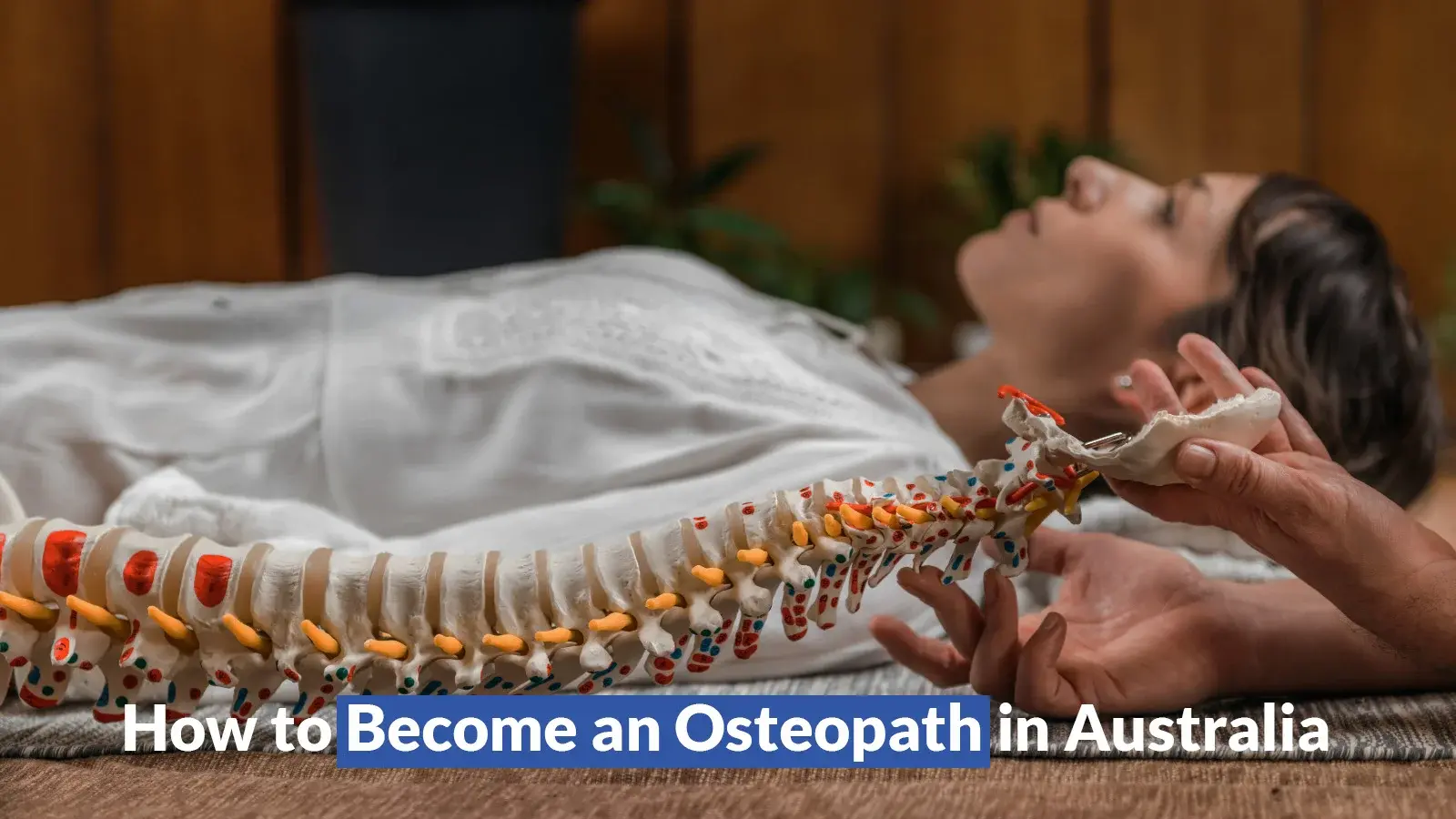Have you considered a career facilitating drug-free healing through skilful touch? As demand for osteopaths surges, this hands-on field offers incredible opportunities to make a difference. To give context, Australian osteopaths conduct around 3.9 million patient visits annually.
A profound understanding of osteopathic fundamentals sets the stage for this fulfilling pursuit. Nonetheless, prior to diving into the requirements of how to become an osteopath in Australia, it’s essential to appreciate the understanding of osteopathy and the significant responsibilities carried by osteopaths.
Understanding Oesthepathy
Osteopathy centres around the connections between the organisation and workings of the body. It utilises drug-free, hands-on treatments to benefit general well-being across all body frameworks.
This is achieved by maintaining and strengthening the musculoskeletal framework.
Osteopaths: Their Role and What They Do
An osteopath in Australia is a government-authorised allied expert with education in regions including physiology, anatomy, pathology, osteopathic methodologies, and diagnosis.
Osteopaths alleviate dysfunction involving muscles, joints, circulation or nerves with manual treatment techniques. By leveraging the body’s innate healing capacities, gentle stretching, massage, joint mobilisation, and positional release encourage lasting well-being.
After conducting diagnostic exams and case history discussions, osteopaths design bespoke hands-on therapy programs. Patients may seek osteopathic care for spinal stiffness, injuries, headaches, digestive issues, and women’s health concerns. Multi-modal approaches empower patients to better self-manage their health.
Osteopathy in Australia: Considering Its Reach and Promise
With over 100 years of history in Australia, osteopathy is an established allied healthcare profession nationwide. Australia helped lead the way globally in building administrative measures to develop osteopathy as a medical services profession.
Osteopathy offers security and freedom along with excellent employment prospects. As Australia’s population ages and interest in drug-free care options grows, demand surges. Osteopathy’s preventative capacities also promise cost savings for the healthcare system.
The Academic Pathway to Becoming an Osteopath
Osteopathic techniques are akin to an art form, helping you connect with your inner self and unlock your body’s natural healing abilities. It’s no wonder the profession is so rewarding! If you are thinking about having a career as an osteopath in Australia, this overview maps out the required stages along the academic pathway:
Step 1: Earning a Bachelor’s Degree in Health Science or a Related Field
Getting a bachelor’s degree in Science, focusing on medical topics, such as biomedicine, is the first step to help you become an osteopath in Australia.
During the degree, students develop foundational knowledge in anatomy, physiology, pathology and clinical sciences alongside introductory osteopathic philosophy.
On the other hand, academic work helps students with critical analysis and investigatory skills supporting empirically validated treatment. The subjects you may study during your bachelor’s degree include:
- Human anatomy and physiology
- Musculoskeletal anatomy and physiology
- Pathology and pharmacology
- Biomechanics and kinesiology
- Osteopathic theory and practice
- Clinical skills and communication
- Research methods and evidence-based practice
- Ethics and law for health professionals
Step 2: Deepening Your Osteopathy Knowledge with a Master’s Degree
After getting a bachelor’s degree, the next step is to finish a Master’s program specifically focused on osteopathy. Postgraduate students dive deeper into evidence-based modalities to assess and treat neuromusculoskeletal conditions.
Extensive practical learning develops clinical reasoning and technical skills like sensitive palpation, biomechanical testing and manipulating tight joints or muscles. Supervised placements in student clinics cement hands-on abilities, applying techniques to help actual patients.
Finalising a master’s degree in osteopathy usually involves around two years, depending on variations in academic institutions and program format. Illustrative topics encountered can include:
- Advanced osteopathic theory and practice
- Osteopathic diagnosis and management
- Osteopathic techniques and modalities
- Clinical integration and case studies
- Clinical research project and dissertation
- Professional practice and development
- Specialised areas of osteopathy, such as paediatrics, geriatrics, women’s health, or sports medicine
Where to Study Osteopathy in Australia:
Currently, six renowned institutions in Australia offer bachelor’s and master’s degrees in osteopathy.
- RMIT University
- Southern Cross University
- University of Western Sydney
- Victoria University
Step 3: Register with the Osteopathy Board of Australia and meet the professional standards
Before professional practice, graduates must register with the National Osteopathy Board of Australia to demonstrate educational background and competency adherence. The OB ensures osteopaths uphold rigorous ethical standards in this self-regulated healthcare field. Registration enables legal practice while connecting practitioners to career-long learning resources.
To register with the OBA, you’ll need to meet the requirements, including:
- Passing the National Osteopathic Exam (written + practical components)
- Providing documentation verifying your identity, qualifications and criminal history
- Demonstrating English language competency
- Paying and renewing the annual registration fee
- Undertaking yearly continuing professional development
- Abiding by all codes of conduct, guidelines and standards
Step 4- Finding a suitable employment opportunity as an osteopath in Australia:
The last step to becoming an osteopath in Australia is to find a reasonable work opportunity or begin your practice. Work options include joining the following:
- Private & Group Practices
- Hospitals
- Aged Care Facilities
- Sports Teams & Institutions
- Primary & Secondary Schools
- Home Clinic Businesses
Aspiring osteopaths may focus on children’s care, elder treatment, female well-being, or sports injury management. Suggested places to help find possibilities cover:
- Osteopathy Australia’s job board, which lists the latest vacancies for osteopaths in Australia
- Seek, Indeed, or other general job search websites, which may also have listings for osteopaths in Australia
- Networking with other osteopaths, either online or in person, through events, forums, or social media
- Contacting potential employers directly, either by phone, email, or visiting their premises
To start your practice, you will need to consider various factors, such as:
- The location, size, and layout of your premises
- The equipment, furniture, and supplies you will need
- The legal, financial, and insurance aspects of running a business
- The marketing, branding, and promotion of your services
- The hiring, training, and management of your staff, if any
The Final Word
So there you have it – the complete guide on how you can become the best osteopath in Australia. It’s a long but rewarding road that starts with foundational health science qualifications before specialising in intricate skills in osteopathic care.
Along the way, you’ll gain insights into the incredible complexity of human anatomy and physiology, study specialised techniques to relieve chronic pain, and learn the art of treating the whole patient – body, mind and lifestyle.
Ultimately, you’ll emerge as a health practitioner and a life-enhancing guide able to significantly improve people’s mobility, pain levels and quality of living.
If you’ve got the drive and compassion to profoundly impact patients suffering from muscular issues, back injuries, headaches and more – then forge a bright future as a qualified and licensed osteopath today!
FAQs
What Do I Have To Study To Become an Osteopath?
You’ll need first to complete an undergraduate health science or biomedical science degree, then finish a university-accredited Master’s program specialising in principles of osteopathic medicine – spanning assessment, diagnosis and evidence-informed treatment of neuromusculoskeletal conditions.
How Long Does It Take To Become an Osteopath Doctor?
The typical end-to-end duration to become a fully qualified and board-registered osteopath doctor in Australia spans 6 to 8 years – starting with a 4-year undergraduate degree, then 2 to 3 years of specialised graduate Master’s level study, plus one year of supervised clinical internship.
Where Can I Study Osteopathy In Australia?
Here are university courses teaching osteopathy in Australia,
- Southern Cross University (Lismore and Gold Coast Campuses)
- RMIT University Melbourne (Bundoora Campus)
- Victoria University Melbourne (City – Flinders)
How Much Does an Osteopath Make in Australia?
The average salary of an Osteopath in Australia is between $70000 and $90000, depending on their specialisation, location, and skills.
Are Osteopaths Equivalent To Doctors In Australia
While osteopaths in Australia may use “doctor” as a title when paired with “osteopath”, they differ professionally from medically licensed physicians (MDs) and don’t share an equivalent scope of medical practice. Osteopaths operate under allied health practitioner status, specifically in hands-on manual therapy and complementary holistic medicine approaches.


